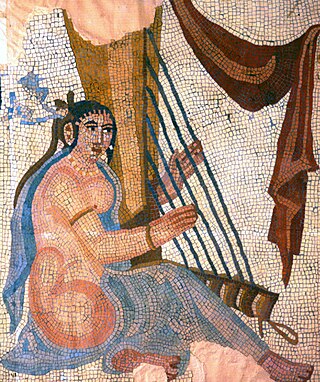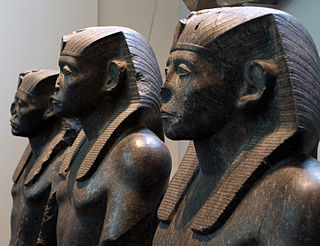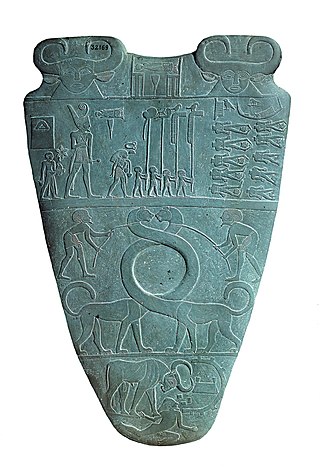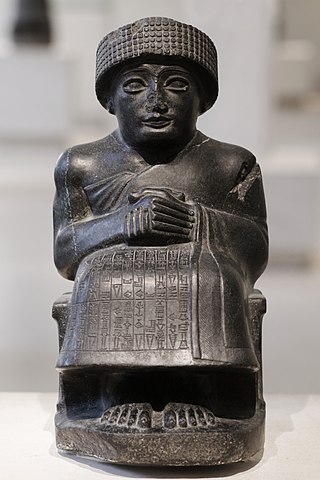Related Research Articles

The Bronze Age is a historical period lasting from approximately 3300 to 1200 BC. It is characterized by the use of bronze, the use of writing in some areas, and other features of early urban civilization. The Bronze Age is the middle principal period of the three-age system, between the Stone and Iron Ages. This system was proposed in 1836 by Christian Jürgensen Thomsen for classifying and studying ancient societies and history. Worldwide, the Bronze Age generally followed the Neolithic period, with the Chalcolithic serving as a transition.
The 3rd millennium BC spanned the years 3000 to 2001 BC. This period of time corresponds to the Early to Middle Bronze Age, characterized by the early empires in the Ancient Near East. In Ancient Egypt, the Early Dynastic Period is followed by the Old Kingdom. In Mesopotamia, the Early Dynastic Period is followed by the Akkadian Empire. In what is now Northwest India and Pakistan, the Indus Valley civilization developed a state society.

The 4th millennium BC spanned the years 4000 BC to 3001 BC. Some of the major changes in human culture during this time included the beginning of the Bronze Age and the invention of writing, which played a major role in starting recorded history.

Lapis lazuli, or lapis for short, is a deep-blue metamorphic rock used as a semi-precious stone that has been prized since antiquity for its intense color. Originating from the Persian word for the gem, lāžward, lapis lazuli is a rock composed primarily of the minerals lazurite, pyrite and calcite. As early as the 7th millennium BC, lapis lazuli was mined in the Sar-i Sang mines, in Shortugai, and in other mines in Badakhshan province in modern northeast Afghanistan. Lapis lazuli artifacts, dated to 7570 BC, have been found at Bhirrana, which is the oldest site of Indus Valley civilisation. Lapis was highly valued by the Indus Valley Civilisation. Lapis beads have been found at Neolithic burials in Mehrgarh, the Caucasus, and as far away as Mauritania. It was used in the funeral mask of Tutankhamun.

The lyre is a stringed musical instrument that is classified by Hornbostel–Sachs as a member of the lute family of instruments. In organology, a lyre is considered a yoke lute, since it is a lute in which the strings are attached to a yoke that lies in the same plane as the sound table, and consists of two arms and a crossbar.

Although definitions of music vary wildly throughout the world, every known culture partakes in it, and it is thus considered a cultural universal. The origins of music remain highly contentious; commentators often relate it to the origin of language, with much disagreement surrounding whether music arose before, after or simultaneously with language. Many theories have been proposed by scholars from a wide range of disciplines, though none has achieved broad approval. Most cultures have their own mythical origins concerning the invention of music, generally rooted in their respective mythological, religious or philosophical beliefs.

Byblos, also known as Jebeil, Jbeil or Jubayl, is an ancient city in the Keserwan-Jbeil Governorate of Lebanon. The area is believed to have been first settled between 8800 and 7000 BC and continuously inhabited since 5000 BC. During its history, Byblos was part of numerous cultures including Egyptian, Phoenician, Assyrian, Persian, Hellenistic, Roman, Genoese, Mamluk and Ottoman. Urbanisation is thought to have begun during the third millennium BC and it developed into a city making it one of the oldest cities in the world. It is a UNESCO World Heritage Site.

Ancient art refers to the many types of art produced by the advanced cultures of ancient societies with different forms of writing, such as those of ancient China, India, Mesopotamia, Persia, Palestine, Egypt, Greece, and Rome. The art of pre-literate societies is normally referred to as prehistoric art and is not covered here. Although some pre-Columbian cultures developed writing during the centuries before the arrival of Europeans, on grounds of dating these are covered at pre-Columbian art and articles such as Maya art, Aztec art, and Olmec art.

Mariachi is an ensemble of musicians that typically play ranchera, the regional Mexican music dating back to at least the 18th century, evolving over time in the countryside of various regions of western Mexico. The usual mariachi group today consists of as many as eight violins, two trumpets and at least one guitar, including a high-pitched vihuela and an acoustic bass guitar called a guitarrón, and all players taking turns singing lead and doing backup vocals.

Ancient music refers to the musical cultures and practices that developed in the literate civilizations of the ancient world, succeeding the music of prehistoric societies and lasting until the Post-classical era. Major centers of ancient music developed in China, Egypt, Greece, India, Iran/Persia, the Maya civilization, Mesopotamia, and Rome. Though extremely diverse, the music of ancient civilizations is frequently characterized by monophony, improvisation, and the dominance of text in musical settings.

Music was ubiquitous throughout Mesopotamian history, playing important roles in both religious and secular contexts. Mesopotamia is of particular interest to scholars because evidence from the region—which includes artifacts, artistic depictions, and written records—places it among the earliest well-documented cultures in the history of music. The discovery of a bone wind instrument dating to the 5th millennium BCE provides the earliest evidence of music culture in Mesopotamia; depictions of music and musicians appear in the 4th millennium BCE; and later, in the city of Uruk, the pictograms for ‘harp’ and ‘musician’ are present among the earliest known examples of writing.

Khakaure Senusret III was a pharaoh of Egypt. He ruled from 1878 BC to 1839 BC during a time of great power and prosperity, and was the fifth king of the Twelfth Dynasty of the Middle Kingdom. He was a great pharaoh of the Twelfth Dynasty and is considered to rule at the height of the Middle Kingdom. Consequently, he is regarded as one of the sources for the legend about Sesostris. His military campaigns gave rise to an era of peace and economic prosperity that reduced the power of regional rulers and led to a revival in craftwork, trade, and urban development. Senusret III was among the few Egyptian kings who were deified and honored with a cult during their own lifetime.

Ancient literature comprises religious and scientific documents, tales, poetry and plays, royal edicts and declarations, and other forms of writing that were recorded on a variety of media, including stone, clay tablets, papyri, palm leaves, and metal. Before the spread of writing, oral literature did not always survive well, but some texts and fragments have persisted. One can conclude that an unknown number of written works too have likely not survived the ravages of time and are therefore lost.

Naqada III is the last phase of the Naqada culture of ancient Egyptian prehistory, dating from approximately 3200 to 3000 BC. It is the period during which the process of state formation, which began in Naqada II, became highly visible, with named kings heading powerful polities. Naqada III is often referred to as Dynasty 0 or the Protodynastic Period to reflect the presence of kings at the head of influential states, although, in fact, the kings involved would not have been a part of a dynasty. In this period, those kings' names were inscribed in the form of serekhs on a variety of surfaces including pottery and tombs.

Ibrahim Maalouf is a French-Lebanese trumpeter, producer, arranger, and composer. In 2022, he became the first Lebanese instrumentalist nominated at the Grammy Awards for his album Queen of Sheba in collaboration with Angélique Kidjo.

African Harps, particularly arched or "bow" harps, are found in several Sub-Saharan African music traditions, particularly in the north-east. Used from early times in Africa, they resemble the form of harps in ancient Egypt with a vaulted body of wood, parchment faced, and a neck, perpendicular to the resonant face, on which the strings are wound.

A musical instrument is a device created or adapted to make musical sounds. In principle, any object that produces sound can be considered a musical instrument—it is through purpose that the object becomes a musical instrument. A person who plays a musical instrument is known as an instrumentalist. The history of musical instruments dates to the beginnings of human culture. Early musical instruments may have been used for rituals, such as a horn to signal success on the hunt, or a drum in a religious ceremony. Cultures eventually developed composition and performance of melodies for entertainment. Musical instruments evolved in step with changing applications and technologies.

The Twenty-ninth Dynasty of Egypt is usually classified as the fourth Dynasty of the Ancient Egyptian Late Period. It was founded after the overthrow of Amyrtaeus, the only Pharaoh of the 28th Dynasty, by Nefaarud I in 398 BC, and disestablished upon the overthrow of Nefaarud II in 380 BC.

The art of Mesopotamia has survived in the record from early hunter-gatherer societies on to the Bronze Age cultures of the Sumerian, Akkadian, Babylonian and Assyrian empires. These empires were later replaced in the Iron Age by the Neo-Assyrian and Neo-Babylonian empires. Widely considered to be the cradle of civilization, Mesopotamia brought significant cultural developments, including the oldest examples of writing.
References
- ↑ "Music & Singing in Egypt". Sis.gov.eg. May 19, 2016. Retrieved 2024-02-06.
- ↑ Museum, United States National (1891). Report Upon the Condition and Progress of the U.S. National Museum During the Year Ending June 30 ... U.S. Government Printing Office – via Google Books.
- ↑ "Harp". MetMuseum.org. The Met Fifth Avenue . Retrieved 2024-02-06.
- ↑ Wright, John W.; et al. (2004). The New York Times Guide to Essential Knowledge . New York: St. Martin’s Press. ISBN 0-312-31367-5.
- ↑ Duchesne-Guillemin, Marcelle (1980). "Sur la Restitution de la Musique Hourrite". Revue de Musicologie (in French). 66 (1): 10. doi:10.2307/928544. JSTOR 928544.